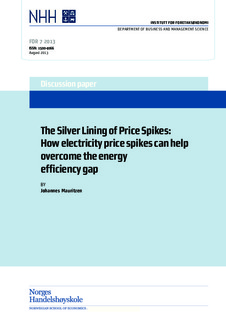The Silver Lining of Price Spikes: How electricity price spikes can help overcome the energy efficiency gap
| dc.contributor.author | Mauritzen, Johannes | |
| dc.date.accessioned | 2014-12-15T10:43:43Z | |
| dc.date.available | 2014-12-15T10:43:43Z | |
| dc.date.issued | 2013-08 | |
| dc.identifier.issn | 1500-4066 | |
| dc.identifier.uri | http://hdl.handle.net/11250/227231 | |
| dc.description.abstract | Studies have shown that many consumers and businesses fail to invest in energy efficiency improvements despite seemingly ample financial incentives to do so – the so-‐called energy efficiency gap. Attempts to explain this gap often focus on searching costs, information frictions and behavioral factors. Using data on Norwegian electricity prices and Google searches for heat pumps, I suggest that the inherently spikey nature of many deregulated electricity markets – often seen as a sign of inefficiency– has a strong and significant positive effect on searching for information on energy efficiency goods. I attempt to identify the informational/behavioral effect by using a novel method of measuring spikiness: decomposing the price series into a range of Loess smoothed series and deviations from these curves. | nb_NO |
| dc.language.iso | eng | nb_NO |
| dc.publisher | FOR | nb_NO |
| dc.relation.ispartofseries | Discussion paper;07/13 | |
| dc.title | The Silver Lining of Price Spikes: How electricity price spikes can help overcome the energy efficiency gap | nb_NO |
| dc.type | Working paper | nb_NO |
Tilhørende fil(er)
Denne innførselen finnes i følgende samling(er)
-
Discussion papers (FOR) [564]
